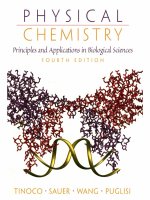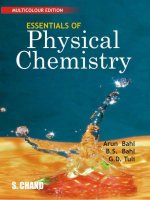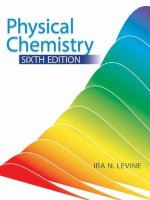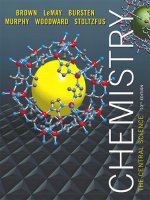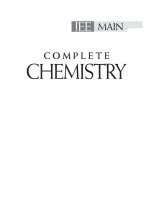Physical chemistry by r l madan
Bạn đang xem bản rút gọn của tài liệu. Xem và tải ngay bản đầy đủ của tài liệu tại đây (42.53 MB, 1,309 trang )
Also available as
1
Book
PHYSICAL
CHEMISTRY
Me
Graw
Hill
Edutatkm
R L Madan
Physical Chemistry
R L Madan
Former Principal , Government College , Panchkula
& Former Head , Chemistry Department
Government Post Graduate College
Faridabad , Haryana
Me
Graw
Hill
Educrtton
McGraw Hill Education (India) Private Limited
NEW DELHI
McGraw Hill Education Offices
New Delhi New York St Louis San Francisco Auckland Bogota Caracas
Kuala Lumpur Lisbon London Madrid Mexico City Milan Montreal
San Juan Santiago Singapore Sydney Tokyo Toronto
www.pdfgrip.com
About the Author
R L Madan has about 35 years of experience in teaching chemistry at the
undergraduate level. After obtaining a PhD in Chemistry, he began his teaching career
at Government Postgraduate College , Gurgaon. Thereafter, he has held positions of
Head of Chemistry Department at Government Postgraduate College, Faridabad, and
Principal, Government College Panchkula and Tigaon ( Faridabad). Prof . Madan has
done extensive research work in the areas of adsorption and surface science at the
Chemistry Department of Indian Institute of Technology , New Delhi. He did
postdoctoral work for studies on polymers at Prague University , Czech Republic, under
a UNESCO fellowship. He has also been awarded a fellowship by the Swedish Institute
for Research Work on Superconductivity at Stockholm University , Sweden. Prof .
Madan has authored several best-selling books on chemistry .
www.pdfgrip.com
Physical Chemistry
www.pdfgrip.com
m
UkKitlan
McGraw Hill Education (India) Private Limited
Published by McGraw Hill Education (India) Private Limited
P- 24, Green Park Extension, New Delhi 110 016
Physical Chemistry
Copyright ©2015 by McGraw Hill Education (India ) Private Limited.
No part of this publication may be reproduced or distributed in any form or by any means,
electronic, mechanical, photocopying, recording, or otherwise or stored in a database or retrieval
system without the prior written permission of the publishers. The program listings (if any ) may
be entered, stored and executed in a computer system, but they may not be reproduced for
publication.
This edition can be exported from India only by the publishers,
McGraw Hill Education (India) Private Limited.
Print Edition:
ISBN (13 digit): 978-12-5906- 254-4
ISBN (10 digit): 12-5906-254-6
EBook Edition:
ISBN (13 digit): 978-93-3290-136-0
ISBN (10 digit): 93-3290-136-8
Managing Director, McGraw Hill Education (India) Private Limited: Kaushik Bellani
—
Head Higher Education (Publishing and Marketing): Vibha Mahajan
Senior Publishing Manager (SEM & Tech. Ed.): Shalini Jha
Associate Sponsoring Editor: Smruti Snigdha
Senior Editorial Researcher: Amiya Mahapatra
Senior Development Editor: Renu Upadhyay
Manager Production Systems: Satinder S Baveja
Assistant Manager Editorial Services: Sohini Mukherjee
Production Executive: Anuj K Shriwastava
—
—
—
Assistant General Manager (Marketing ) Higher Education: Vijay Sarathi
Senior Graphic Designer Cover: Meenu Raghav
—
—
General Manager Production: Rajender P Ghansela
Manager Production: Reji Kumar
—
Information contained in this work has been obtained by McGraw Hill Education (India ), from
sources believed to be reliable. However, neither McGraw Hill Education (India ) nor its authors
guarantee the accuracy or completeness of any information published herein, and neither
McGraw Hill Education (India ) nor its authors shall be responsible for any errors, omissions, or
damages arising out of use of this information. This work is published with the understanding
that McGraw Hill Education (India ) and its authors are supplying information but are not
attempting to render engineering or other professional services. If such services are required,
the assistance of an appropriate professional should be sought.
www.pdfgrip.com
Typeset at Tej Composers, WZ 391, Madipur, New Delhi 110 063.
eBook Conversion by DigiConv Technologies, C-240, 1st Floor, Pandav Nagar, Delhi - 110092.
www.digiconv.com
www.pdfgrip.com
Dedicated to the Memory of
My Loving Mother
Late Mrs janki Devi
Who made me what I am and to whom I owe a lot
www.pdfgrip.com
Foreword
Chemistry has made a significant impact on society and is intimately linked to the wellbeing of humankind. The rate of advancement of basic sciences is so high that
academicians look forward for strategies to cope with those advancements. Physical
chemistry provides a decent bridge between mathematical sciences and experimental
sciences. The present textbook is a sincere effort in this direction. This book provides a
unified approach to the study of chemistry for undergraduate (Pass and Honours)
students. The text is well illustrated with examples from surrounding environments
which will help students grasp the concepts easily .
There are several highlights of this book. The chapter dealing with mathematical
concepts and computers will provide a powerful tool to students in understanding the
basic concepts and solve numerical problems in shorter time. Partial differentiation and
integration needs special mention in this regard. Incorporation of computers and
introducing analog and digital devices will provide a good basic platform to
understanding physical chemistry Biographical sketches of some scientists relevant to
particular topics will surely enthuse students. Liquid state, colloidal state chemical
kinetics and thermodynamics have been written especially in a systematic, lucid and
comprehensible style. Learning objectives have been given exhaustively in each chapter
of the book. Sufficient examples have been given at the end of each chapter, along with
summary for quick revision, key relations, question bank including multiple-choice
questions and general questions so that students can evaluate their learning potential
themselves.
The level of text material in each chapter is sufficient to escalate this book to
international standard. I am sure this book will procure the author and publishers a good
name in the market. The hard work done by the author is commendable and deserves to
be congratulated. I wish huge success to this book.
N K Sandle
Prof . Department of Chemistry, Indian Institute of Technology (IIT), Delhi
www.pdfgrip.com
Contents
Preface
Basic Concepts
1.
Introduction
1.1
1.2
Systems of Measurement
Massand Weight
1.3
Volume
1.4
Scientific Notation
1.5
1.6
Uncertainty
Dimensional Analysis
1.7
Summary
Exercises
Short-Answer Questions
General Questions
Mathematical Concepts and Computers
2.
Introduction to Mathematical Concepts
2.1
2.2
Logarithmic Relations
Curve Sketching
2.3
2.4
Linear Graphs and Calculation of Slopes
Differentiation
2.5
2.6
Maxima and Minima
2.7
Partial Differentiation
2.8
Integration
Definite Integral
2.9
Factorials
2.10
2.11
Permutations and Combinations
2.12
Probability
2.13
Mutually Exclusive Events
Introduction to Computers
2.14
2.15
Components of a Computer
Hardware and Software
2.16
2.17
Binary System
2.18
Binary Arithmetic
2.19
Operating System
2.20
Computer Programming
Summary
www.pdfgrip.com
3.
.
4
5.
Exercises
General Questions
Gaseous State
Introduction
3.1
3.2
Kinetic Theory of Gases
Maxwell Distribution of Velocities
3.3
Most Probable Velocity ( a), Average Velocity (v) and Root
3.4
Mean Square ( RMS) Velocity (u)
3.5
Degree of Freedom
3.6
Principle of Equipartition of Energy
Collision Diameter, Collision Number, Collision Frequency and
3.7
Mean Free Path
3.8
Viscosity of Gases
The Barometric Formula
3.9
Ideal Gas and Real Gas
3.10
Critical Phenomenon
3.11
3.12
Liquefaction of Gases
Summary
Exercises
General Questions
The Liquid State
Introduction
4.1
4.2
Vapour Pressure of a Liquid
Surface Tension of a Liquid
4.3
4.4
Determination of Surface Tension
Parachor
4.5
4.6
Viscosity
Rheochor
4.7
Refractive Index
4.8
4.9
Liquid Crystals
Summary
Exercises
Short Answer Questions
General Questions
The Solid State
Introduction
5.1
5.2
Types of Solids
5.3
Types of Crystals
5.4
Space Lattice and Unit Cell of a Crystal
5.5
Packing of Particles in a Crystal
Radius Ratio
5.6
Number of Atoms in a Unit Cell for Simple Cubic, FCC and
5.7
BCC Structures
Fundamental Laws of Crystallography
5.8
Miller Indices
5.9
5.10
Isomorphism and Polymorphism
5.11
Point Groups and Space Groups
5.12
Investigation of Internal Structure of a Solid by X -Ray
Diffraction
Summary
www.pdfgrip.com
6.
7.
8.
Exercises
General Questions
Colloidal State
Introduction
6.1
6.2
Classification of Colloids
Micelles
6.3
6.4
Preparation of Colloidal Solutions
6.5
Properties of Sols ( Colloidal Solutions)
Protective Colloids and Gold Number
6.6
Emulsions
6.7
Gels
6.8
Various Methods to Determine the Size of Colloidal Particles
6.9
6.10
Applications of Colloids
Summary
Key Equations
Exercises
General Questions
Chemical Kinetics
Introduction
7.1
Factors Affecting Rate of a Reaction
7.2
7.3
Molecularity of a Reaction
Rate Law and Rate Constant
7.4
7.5
Zero -Order Reaction
First-Order Reaction
7.6
Radioactive Decay as a First-Order Phenomenon
7.7
Second-Order Reaction
7.8
Third-Order Reaction
7.9
Relations between Half -Life Period and Order of a Reaction
7.10
Formulation of Mechanism of a Reaction
7.11
Methods for the Determination of Order of a Reaction
7.12
7.13
Complications in the Determination of Order of Reaction
Surface Reactions
7.14
Chain Reactions
7.15
7.16
Temperature Dependence and Arrhenius Equation
Collision Theory of Reaction Rates
7.17
7.18
Transition State Theory or Theory of Absolute Reaction Rates
or Theory of Activated Complex Formation
7.19
Experimental Methods of Chemical Kinetics
Summary
Key Equations
Exercises
General Questions
Catalysis
Introduction
8.1
General Characteristics of Catalysed Reactions
8.2
Theories of Catalysis
8.3
8.4
Important Features of Solid Catalysts
8.5
Shape-Selective Catalysis by Zeolites
8.6
Homogeneous Catalysis
8.7
Heterogeneous Catalyis
www.pdfgrip.com
Enzyme Catalysis
Auto catalysis
Summary
Key Relations
Short-Answer Questions
General Questions
Thermodynamics-I
Introduction
9.1
Joule ’s Law
9.2
Calculation of Values of w, q , AH and AH in Adiabatic
9.3
Expansion of an Ideal Gas
Summary
Key Relations
Exercises
Short-Answer Questions
General Questions
Thermochemistry
Introduction
10.1
Latest Sign Conventions for Q or AH, AH and W
10.2
Heat of Reaction (or Enthalpy of Reaction)
10.3
Standard State
10.4
Different Kinds of Heat (or Enthalpy ) of Reaction
10.5
Hess’s Law of Constant Heat Summation
10.6
Bond Enthalpy or Bond Energy
10.7
Variation of Heat of Reaction with Temperature Kirchhoff ’s
10.8
Equation
Summary
Key Relations
Exercises
Short-Answer Questions
General Questions
Themodynamics- II
Introduction
11.1
Carnot Cycle
11.2
11.3
Thermodynamic Scale of Temperature
11.4
Concept of Entropy
11.5
Entropy Change for an Ideal Gas Under Different Conditions
11.6
Entropy Change on Mixing of Ideal Gases
Helmholtz Free Energy
11.7
Gibbs Free Energy (or Gibbs Energy )
11.8
Criteria for Feasibility or Spontaneity of a Process
11.9
Maxwell Relationships
11.10
Gibbs-Helmholtz Equation
11.11
Summary
Key Relations
Exercises
Short-Answer Questions
General Questions
Themodynamics- III
Third Law of Thermodynamics
12.1
8.8
8.9
9.
10.
—
11.
12.
www.pdfgrip.com
13.
14.
Statements of Third Law of Thermodynamics
12.2
Residual Entropy
12.3
12.4
Partial Molar Properties (Open Systems)
Clausius-Clapeyron Equation
12.5
Fugacity and Activity
12.6
Summary
Key Relations
Exercises
Short-Answer Questions
General Questions
Chemical Equilibrium
Introduction
13.1
The State of Chemical Equilibrium
13.2
Law of Mass Action
13.3
13.4
Applications of Equilibrium Constant
13.5
Partial Molar Quantities
Free- Energy Change as a Criterion of Spontaneity
13.6
13.7
Thermodynamic Derivation of the Law of Chemical
Equilibrium
VanT Hoff Reaction Isotherm
13.8
Relation between Kp and Kc
13.9
VanT Hoff Equation for Temperature Dependence of
13.10
Equilibrium Constant (Van’t Hoff Reaction Isochore)
Le-Chatelier’s Principle
13.11
Clausius-Clapeyron Equation
13.12
Hammett Equation
13.13
Summary
Exercises
Short-Answer Questions
General Questions
Phase Equilibria and Phase Rule
Introduction
14.1
14.2
Explanation of the Terms
14.3
Equilibrium
Thermo dynamic Derivation of Phase Rule
14.4
Different Techniques for the Determination of Transition Point
14.5
Phase Diagram
14.6
Phase Diagram of the Water System
14.7
Solid-Liquid Phase Transition
14.8
Phase Diagram of Carbon Dioxide System
14.9
Phase Diagram of Sulphur System
14.10
Two -Component Systems
14.11
14.12
Types of Two -Component Systems Involving Solid-Liquid
Equilibria
14.13
Experimental Determination of Phase Diagram of Two
Component Systems
14.14
Study of Some Two -Component Systems
14.15
Freezing Mixtures
Phase Diagram of Magnesium- Zinc System
14.16
Phase Diagram of Ferric Chloride-Water Systems
14.17
www.pdfgrip.com
15.
16.
Phase Diagram of Na2S04 - H 2O System
14.18
Sodium Chloride-Water System
14.19
Phase Diagram of Copper Sulphate-Water System
14.20
Summary
Exercises
Short-Answer Questions
General Questions
Distribution Law
Nernst Distribution Law — Introduction
15.1
15.2
Thermodynamic Derivation of Distribution Law
Modification in Distribution Law in Case of Change in
15.3
Molecular State
15.4
Applications of Distribution Law
15.5
Studying Chemical Equilibrium Involving Formation of
Complex Compounds
15.6
Utility of Distribution Law in the Process of Extraction
General Formula for Amount of Substance Left Unextracted
15.7
and Volume of Extracting Liquid used Each Time
Determination of Degree of Hydrolysis from Distribution Law
15.8
Summary
Key Relations
Exercises
Short-Answer Questions
General Questions
Electrochemistry-I
Introduction
16.1
Electrical Resistance and Electrical Conductance
16.2
Measurement of Electrolytic Conductance, Specific
16.3
Conductivity , Equivalent Conductivity and Molar Conductivity
Numerical Problems on Specific, Equivalent and Molar
16.4
Conductivities
Effect of Dilution on Specific Conductance and Equivalent
16.5
Conductance
Arrhenius Theory of Ionisation
16.6
Ostwald Dilution Law
16.7
Variation of Conductivity with Concentration of Strong
16.8
Electrolytes (Debye- Huckel- Onsagar Equation)
Kohlrausch ’s Law
16.9
Anomalous Behaviour of Strong Electrolytes Debye- Huckel
16.10
Theory
16.11
Migration of Ions and Transport Number
Hittorf ’s Theoretical Device Change in Concentration
16.12
16.13
Transport Number
16.14
Moving Boundary Method for the Determination of Transport
Numbers
Conductometric Titrations
16.15
Summary
Key Relations
Exercises
Short-Answer Questions
—
www.pdfgrip.com
17.
18.
General Questions
Electrochemistry- II
Buffer Solution Introduction
17.1
Henderson Equation for the pH of a Buffer Mixture
17.2
Buffer Capacity and Buffer Index
17.3
Neutralization Phenomenon
17.4
Salt Hydrolysis
17.5
17.6
Hydrolysis Constant and Degree of Hydrolysis
17.7
Expressions for the Hydrolysis Constant, Degree of Hydrolysis
and pH of Solutions of Salts of Strong Acid and Weak Base
17.8
Expressions for the Hydrolysis Constant, Degree of Hydrolysis
and pH of Solution of a Salt of Weak Acid and Strong Base
17.9
Expressions for Hydrolysis Constant, Degree of Hydrolysis and
pH of Solutions of Salts of Weak Acid and Weak Base
—
Summary
Key Relations
Exercises
Short-Answer Questions
General Questions
Electrochemistry- III
Electrochemical Cell
18.1
18.2
Electrolytic Cell
Schematic Representation of an Electrochemical Cell
18.3
18.4
Emf of a Cell
Weston Standard Cell
18.5
Reversible Cell
18.6
Irreversible Cell
18.7
18.8
Types of Electrodes
18.9
Relationship between Electrical Energy and Chemical Energy
18.10
Expressions for AG , AH and AS in Terms of Temperature
Coefficient of the Emf
Measurement of Electrode Potentials of Zinc Electrode and
18.11
Copper Electrode
Reference Electrodes
18.12
Electrochemical Series
18.13
18.14
Activity and Activity Coefficient of Electrolytes
Nemst Equation for Measuring Emf of a Cell
18.15
Nemst Equation for Single Electrode Potential
18.16
Electrode Potential of Reduction-Oxidation Electrode
18.17
Calculation of Equilibrium Constant (K) from Nernst Equation
18.18
Irreversible Electrode Processes
18.19
Concentration Cells
18.20
18.21
Emf of Electrode Concentration Cell without Transference
18.22
Emf of Electrolyte Concentration Cells without Transference
18.23
Emf of an Electrolyte Concentration Cell with Transference
18.24
Liquid Junction Potential
18.25
Determination of Activity and Activity Coefficient from Emf
Measurement
18.26
Applications of emf Measurements
Different Types of Electrodes in Practical Use
18.27
www.pdfgrip.com
19.
18.28
Determination of pH or H+ Concentration of a Solution by emf
Measurement
18.29
Potentiometric Titrations
Corrosion
18.30
Electrochemical Theory of Corrosion
18.31
Methods of Prevention of Corrosion
18.32
Summary
Key Relations
Exercises
Short-Answer Questions
General Questions
Atomic Structure and Quantum Mechanics
Introduction
19.1
Classical Mechanics
19.2
Black Body and Black- Body Radiations
19.3
Kirchhoff ’s Law of Black -Body Radiations
19.4
19.5
Spectral Distribution of Black-Body Radiation
Planck ’s Radiation Law
19.6
Photoelectric Effect
19.7
Heat Capacity of Solids
19.8
Quantum Mechanics
19.9
Bohr’s Model of Atom
19.10
De Broglie Hypothesis ( Dual Nature of Matter and Radiations)
19.11
19.12
Heisenberg’s Uncertainty Principle
The Compton Effect
19.13
Sinusoidal Wave Equation
19.14
19.15
Schrodinger Wave Equation
Born’s Interpretation and Significance of Wave Function ( V7)
19.16
Normalised and Orthogonal Wave Functions
19.17
19.18
Operators
Postulates of Quantum Mechanics
19.19
19.20
Derivation of Schrodinger Wave Equation Based on the
Postulates of Quantum Mechanics
Particle in a One - Dimensional Box
19.21
Calculation of Expectation Values using Wave Function
19.22
Particle in a Three- Dimensional Box
19.23
19.24
Concept of Degeneracy
19.25
Schrodinger Wave Equation in Terms of Polar ( Spherical)
Coordinates
19.26
Separation of Variables
19.27
Expressions for Angular Spherical Wave Functions
19.28
Expression for the Radial Wave Function
Quantum Numbers from Schrodinger Wave Equation
19.29
19.30
Concept of Orbital
19.31
Shapes of Orbitals
Summary
Key Relations
Exercises
Short-Answer Questions
General Questions
www.pdfgrip.com
20.
21.
Quantum Mechanics and Chemical Bonding
Quantum Mechanics and Chemical Bonding
20.1
20.2
Valence Bond Theory
20.3
Molecular Orbital Theory
20.4
Physical Picture of Bonding and Antibonding Wave Functions
Variation of Electron Probability Density Along Internuclear
20.5
Axis in Bonding and Antibonding Molecular Orbitals
20.6
Formation of Molecular Orbitals from Atomic Orbitals
20.7
Concept of O , a* , TT , TT * Orbitals and their Characteristics
20.8
Formation of H 2 Molecule
20.9
Hybridisation
Quantum Mechanical Principles of Hybridisation
20.10
Calculation of the Coefficients of Atomic Orbitals in different
20.11
Hybrid Orbitals
20.12
Comparison of Valence Bond ( VB) Molecular Orbital ( MO)
Models
Summary
Key Relations
Exercises
Short-Answer Questions
General Questions
Spectroscopy
Introduction
21.1
Rotational, Vibrational and Electronic Energies of Molecules
21.2
Molecular Spectroscopy Versus Atomic Spectroscopy
21.3
21.4
Absorption and Emission Spectroscopy
21.5
Types of Molecular Energies and Born-Oppenheimer
Approximation
21.6
Types of Molecular Spectra
Selection Rules for Rotational and Vibrational Spectra
21.7
Width and Intensities of the Spectral Lines
21.8
21.9
Degrees of Freedom
Pure Rotational Spectra of Diatomic Molecules
21.10
21.11
Nonrigid Rotor ( Qualitative Description)
21.12
Isotopic Effect
Vibrational Spectra of Diatomic Molecules (Infrared Spectra)
21.13
Vibrational Energy of an Anharmonic Oscillator ( Morse
21.14
Equation)
Vibrational- Rotational Spectra Obtained for a Diatomic
21.15
Molecule Taking it as Anharmonic Oscillator
21.16
Applications of Study of Infrared Spectrum
Vibrational Frequencies of Functional Groups
21.17
Introduction
21.18
Rotational-Vibrational Raman Spectra of Diatomic Molecules
21.19
Introduction
21.20
Born- Oppenheimer Approximation in Relation to Electronic
21.21
Spectra of Molecules
Potential Energy Curve and Frank-Condon Principle
21.22
Electronic Transition in o, TT, and n Molecular Orbitals
21.23
Exercises
www.pdfgrip.com
22.
23.
24.
Short-Answer Questions
General Questions
Photochemistry
Introduction
22.1
Differences between Thermochemical and Photochemical
22.2
Reactions
Lambert’s Law of Transmission of Light
22.3
Beer’s Law
22.4
Laws of Photochemistry
22.5
Quantum Efficiency or Quantum Yield
22.6
Some Examples of Photochemical Reaction
22.7
22.8
Luminescence
Excitation of Electrons (Jablonski Diagram )
22.9
Photosensitisation
22.10
Photochemical Equilibrium
22.11
Summary
Key Relations
Exercises
Short-Answer Questions
General Questions
Physical Properties and Molecular Structure
Introduction
23.1
23.2
Optical Activity
Measurement of Optical Activity
23.3
Cause of Optical Activity in a Compound
23.4
23.5
Dipole Moment
Polarisation of Molecules (Induced Polarisation)
23.6
23.7
Dipole Moment and Structure of Molecules
23.8
Magnetic Susceptibility
23.9
Explanation of Diamagnetism and Paramagnetism
23.10
Determination of the Magnetic Moment of a Paramagnetic
Substance
23.11
Applications of Magnetic Susceptibility Measurement
Summary
Key Relations
Exercises
Short-Answer Questions
General Questions
Liquid-Liquid Mixtures
Introduction
24.1
24.2
Expressing Concentration of Solutions
Raoult’s Law
24.3
24.4
Henry ’s Law
Duhem - Margules Equation
24.5
24.6
Completely Soluble Liquids
24.7
Vapour Pressure Composition Diagram for Ideal Solutions
24.8
Vapour Pressure Composition Curves for Non-Ideal Solutions
( Derivation from Ideal Behaviour)
24.9
Principle of Distillation of Binary Miscible Liquids
Distillation of Binary Miscible Solutions
24.10
www.pdfgrip.com
25.
26.
Azeotropes
24.11
Immiscible Liquids
24.12
Steam Distillation
24.13
Partially Miscible Liquids
24.14
Effect of Impurities on Consolute Temperature (Critical
24.15
Solution Temperature)
Summary
Key Relations
Exercises
Short-Answer Questions
General Questions
Dilute Solutions and Colligative Properties
Introduction
25.1
Determination of Vapour Pressure of a Liquid by Manometric
25.2
Method
Determination of Lowering of Vapour Pressure of the Solvent
25.3
Relation between the Relative Lowering of Vapour Pressure
25.4
and the Molecular Mass of the Solute ( Raoult ’s Law )
Osmosis Phenomenon
25.5
Van’t Hoff Relation between the Osmotic Pressure of a Solution
25.6
and Molecular Mass of the Solute
Van’t Hoff Theory of Dilute Solution Taking the Example of
25.7
Osmosis
25.8
Determination of Osmotic Pressure
Theories of Osmosis
25.9
Elevation in Boiling Point
25.10
Relation between Elevation in Boiling Point of Solution and
25.11
Molecular Mass of Solute
25.12
Depression in Freezing Point
Relation between Depression in Freezing Point and Molecular
25.13
Mass of the Solute
Van ’t Hoff Factor
25.14
Summary
Key Relations
Exercises
Short-Answer Questions
General Questions
Adsorption
Introduction
26.1
26.2
Physical Adsorption and Chemical Adsorption
26.3
Adsorption Isotherm
Freundlich Adsorption Isotherm
26.4
26.5
Langmuir Theory of Adsorption
Bet Equation
26.6
26.7
Adsorption by Solids from Solutions
Gibbs Adsorption Equation
26.8
26.9
Applications of Gibbs Adsorption Equation
26.10
Applications of Adsorption
Summary
Key Relations
www.pdfgrip.com
27.
28.
Exercises
Short-Answer Questions
General Questions
Polymers
Introduction
27.1
Terms used in Relation to Polymers
27.2
Natural and Synthetic Polymers
27.3
Number Average and Mass- Average Molecular Masses
27.4
Methods for the Determination of Molecular Masses
27.5
27.6
Step Polymerisation
Summary
Key Relations
Exercises
Short-Answer Questions
General Questions
Nuclear Chemistry
28.1
Isotopes
Fundamental Particles of the Nucleus
28.2
Natural Radioactivity
28.3
Artificial Disintegration or Transmutation of Elements
28.4
Q Value of Nuclear Reactions
28.5
Nuclear Fission
28.6
Nuclear Fusion
28.7
28.8
Applications of Radioactivity
28.9
Tracer and Tracer Technique
28.10
Applications of Tracer ( Radio Isotopes) Technique
28.11
Design of Nuclear Reactor
28.12
Soddy ’s Group- Displacement Law
Summary
Key Relations
Exercises
Short -Answer Questions
General Questions
www.pdfgrip.com
I feel immensely pleased to present Physical Chemistry to the teaching fraternity and the
students. Physical chemistry is the study of macroscopic, atomic, sub-atomic and
particulate phenomena in chemical systems. It applies the principles, practices and
concepts of motion, energy , force, time, thermodynamics, quantum chemistry , statistical
mechanics and equilibrium.
Physical chemistry , a branch of chemistry , is a core subject at undergraduate science
and technology course curricula of different universities and autonomous institutes in
the country . In the study of this subject for the above courses, a number of books by
foreign authors are widely used as reference books. The teaching fraternity in India was
feeling the need of a textbook written in a simple language and an interesting manner
which could be grasped even by an average student. The present book has been written
in response to the aspirations of the teaching community and the students.
Target Audience
This book covers the syllabus of Physical Chemistry for the students of BSc I, II and III
( Pass and Honours or Major and Minor) of different Indian Universities. Students of
other undergraduate professional courses having physical chemistry as a major subject
may also use this book. The only prerequisite is that the students must possess a basic
knowledge of chemistry of 11th and 12th standard to utilize this book. A basic
knowledge of mathematics is also expected.
Salient Features
P Covers all important topics
Gaseous State, Liquid State, Solid State, Colloidal
State, Chemical Kinetics, Catalysis, Thermodynamics, Chemical Equilibrium, Phase
Equilibria , Distribution Law, Electrochemistry , Atomic Structure and Wave
Mechanics, Chemical Bonding and Wave Mechanics, Spectroscopy ,
Photochemistry , Physical Properties and Molecular Structure, Liquid Solutions,
Dilute Solutions, Adsorption, Polymers and Nuclear Chemistry
P Latest IUPAC notations and SI units used
P Principles and laws explained in the simplest possible way
www.pdfgrip.com
P
P
P
P
Analogies from daily life used to clarify difficult points
Concept explanation through more than 1200 step-wise solved problems
Numerical problems for practice
Applications and case studies like applications of equilibrium constant, cases to
understand structure of liquid crystals and how they flow
P More than 500 line, phase, and real-time illustrations
•
•
•
•
•
•
•
•
Prologue on mathematical concepts
Key words and Key relations provided in the summary
Concept boxes to highlight important facts that are asked in examinations
Special features such as interesting facts, common pitfalls, key terms
interspersed
Subject index provided for quick location of terms, laws, theories, etc.
Over 450 solved examples covering all types of problems in different
chapters
More than 800 review questions
Over 400 objective-type questions
About the Book
The style of the book is such that it encourages students to understand physical
chemistry rather than learn it by rote memorization. Simple and comprehensible
language has been used to explain the principles involved in different topics. The
opening chapter, Basic Concepts, acquaints the students with different systems and units
of physical quantities. As recommended by IUPAC and CGPM, SI system of
measurement and units of physical quantities have been followed by and large, although
CGS system has been retained in some problems. This is because questions in some
university papers still appear in CGS units. IUPAC has recommended changes in the
names of certain terms, for example, conductivity in place of specific conductance, and
Gibbs energy in place of Gibbs free energy. This has been highlighted in the chapters on
electrochemistry and thermodynamics. Readers can refer to the Table of Content to
know more about the topics covered in this book.
Biographical sketches of scientists are given to inspire and stimulate the minds of
students towards the subject. Analogies from daily life have been chosen to explain
intricate points. Historical developments leading to the establishment of different
theories and laws have found due place in the book. How the different principles of
physical chemistry come to the rescue of people in difficult situations has been
explained with the help of interesting pictures. Although this part is non-evaluative, it
makes the subject exciting and easily understandable. The text is supported by a large
number of solved examples and problems for practice .
Learning Objectives given at the beginning of each chapter give the detailed
contents of the chapter. Summary provided at the end of a chapter lists the important
information in brief for last-minute revision before the examination. Also given in the
summary are Key Points and Key Relations, which are required in solving numerical
problems. Exercises consist of two parts, objective evaluation and subjective evaluation.
As per the latest recommendation on the setting of question papers, multiple- choice
questions, fill-in-the-blanks questions, short-answer questions and general (longwww.pdfgrip.com
answer) questions have been provided to prepare the students to face examinations
boldly .
Online Learning Center
The text is accompanied by an Online Learning Center, which can be accessed at
https://www .mhhe .com /madan /pcl. This includes objective-type questions, concept
boxes, and answers to unsolved problems.
Acknowledgements
I express my thanks and regards to my mentor and Ph . D. guide Prof . N. K. Sandle,
Department of chemistry , Indian Institute of Technology (IIT), New Delhi for providing
me inspiration and support during the preparation of the book.
I thank all the reviewers who read the initial manuscript and gave commendable
suggestions, some of which have been incorporated in the text. Their names are given
below:
Rabinarayan
Panda
KM Gardakar
P H Parsania
V Kannapan
J
Sanathanalakshmi
Sasmita Dash
Swarnalakshmi
Birla Institute of Technology and Science ( BITS ), Pilani ,
Rajasthan
Shivaji University , Kolhapur , Maharashtra
Saurashtra University , Rajkot , Gujarat
University of Madras , Chennai , Tamil Nadu
University of Madras , Chennai , Tamil Nadu
Annamalai University , Chidambaram , Tamil Nadu
Guru Nanak College , Chennai , Tamil Nadu
I place on record the efforts made by Ms Renu upadhayay , Mr Anuj Srivastava and
other staff of McGraw Hill Education to ensure the smooth publication of the book.
Readers are welcome to send constructive criticism and feedback to me at
rattanlal.madan@ gmail.com
RL Madan
Publisher’s Note
McGraw Hill Education (India) invites suggestions and comments from you, all of
which can be sent to info.india @mheducation .com (kindly mention the title and author
name in the subject line). Piracy -related issues may also be reported.
www.pdfgrip.com
r -
Ir
?
>-?
5R
Basic Concepts
\
'
*
W
LEARNING OBJECTIVES
Acquaint with different systems of measurement of different quantities
Understand how we gradually shifted from the British system to the metric system
Know the seven basic physical quantities and their units
Learn in detail about the units of the seven physical quantities
Differentiate between mass and weight
Write very large or very small numbers in scientific notation
Carry out arithmetical calculations using exponential notation
Differentiate between precision and accuracy
Define significant figures and learn the rules for deciding significant figures in different
kinds of numbers
Learn addition, subtraction, multiplication and division ofsignificantfigures
Learn conversion of units from one system to another through dimensional analysis
1.1 INTRODUCTION
A substance is associated with physical properties and chemical properties. Some examples of
physical properties are colour, odour, smell, density, melting point and boiling point. These
properties can be measured without the substance undergoing decomposition or association.
Observation of a chemical property requires a chemical change to occur. Chemical properties of
a substance include acidic or basic nature, combustibility, etc.
We require some parameters to assess certain properties. For example, properties like length,
width, area, volume, etc., are quantitative in nature. That is, they are associated with definite
values. Any quantitative measurement is represented by a number followed by units in which it
is measured. It is absurd to say that a particular substance measures 6 in length we need to
specify whether it is 6 cm or 6 m . When we say it is 6 m long, we mean it measures 6 units on
the scale of metre.
—
1.2
I
SYSTEMS OF MEASUREMENT
In scientific studies and research, two different systems of measurement have been in use. These
are the English System and the Metric System The metric system originated in France in the
late eighteenth century and is more convenient to use because it is based on the decimal system
.
www.pdfgrip.com
of numbers. Before 1960, both the systems of measurement were being used by the scientific
community. Some parts of the globe preferred the English system because they were used to it.
Greater proportion of the scientific population advocated a switch to the metric system because
it was more convenient and hence more scientific.
The metric system is called the International System of Units (called Le Systems
International d’ Unites in French and abbreviated as SI units). Historically, this system was
established by the 11th General Conference on Weights and Measures (Conference General des
Poides at Measures in French and abbreviated as CGPM ). The CGPM is an intergovernmental
treaty organization created by a diplomatic treaty known as Meter Convention which was signed
in Paris in 1875.
As a consequence of serial meetings of the international scientific community, it was agreed
in 1960 to adopt SI units for scientific experimentation and studies, although both the units
continue to be used in textbooks. We have been rather slow in adopting SI units in our works.
The SI system has seven base units pertaining to seven fundamental quantities as listed in Table
1.1.
Table 1.1 Seven basic physical quantities and their units
Physical Quantity
Symbol for
Quantity
Name of SI
Unit
Symbol for SI
Unit
Length
/
metre
m
Mass
m
kilogram
kg
Time
t
second
s
Electric current
I
ampere
A
Thermodynamic
temperature
f
kelvin
K
Amount ofthe substance
n
mole
mol
Luminous intensity
Iy
candela
cd
SI base units are separately defined as under:
1. Metre The metre is the length ofthe path travelled by light in vacuum during a
time interval of 1/299792458 of a second.
2. Kilogram The kilogram is equal to the mass ofthe international prototype of
the kilogram.
3. Second The second is the duration of 9192631770 periods of radiation
corresponding to the transition between the two hyperfine levels ofthe ground
state ofthe caesium-133 atom.
4. Ampere The ampere is that constant current which, if maintained in two
straight parallel conductors of infinite length, of negligible circular cross section
www.pdfgrip.com


